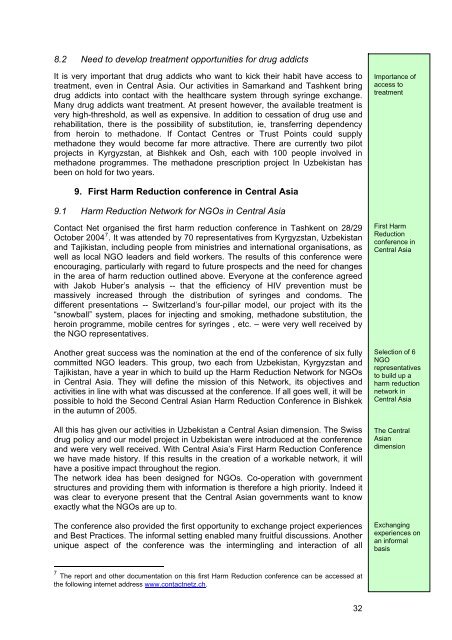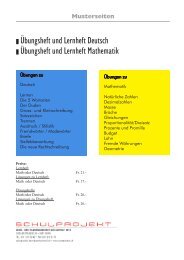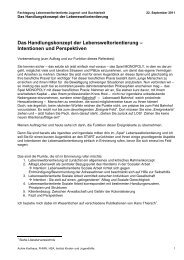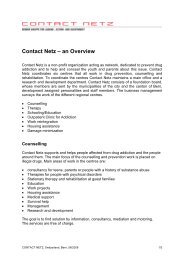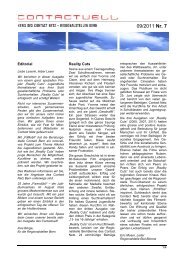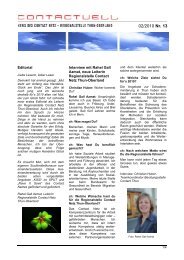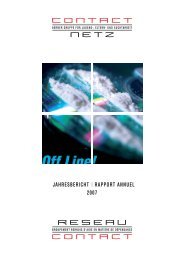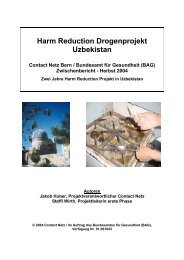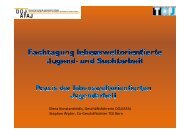Harm Reduction Drug Project Uzbekistan - Contact Netz
Harm Reduction Drug Project Uzbekistan - Contact Netz
Harm Reduction Drug Project Uzbekistan - Contact Netz
You also want an ePaper? Increase the reach of your titles
YUMPU automatically turns print PDFs into web optimized ePapers that Google loves.
8.2 Need to develop treatment opportunities for drug addicts<br />
It is very important that drug addicts who want to kick their habit have access to<br />
treatment, even in Central Asia. Our activities in Samarkand and Tashkent bring<br />
drug addicts into contact with the healthcare system through syringe exchange.<br />
Many drug addicts want treatment. At present however, the available treatment is<br />
very high-threshold, as well as expensive. In addition to cessation of drug use and<br />
rehabilitation, there is the possibility of substitution, ie, transferring dependency<br />
from heroin to methadone. If <strong>Contact</strong> Centres or Trust Points could supply<br />
methadone they would become far more attractive. There are currently two pilot<br />
projects in Kyrgyzstan, at Bishkek and Osh, each with 100 people involved in<br />
methadone programmes. The methadone prescription project In <strong>Uzbekistan</strong> has<br />
been on hold for two years.<br />
9. First <strong>Harm</strong> <strong>Reduction</strong> conference in Central Asia<br />
9.1 <strong>Harm</strong> <strong>Reduction</strong> Network for NGOs in Central Asia<br />
<strong>Contact</strong> Net organised the first harm reduction conference in Tashkent on 28/29<br />
October 2004 7 . It was attended by 70 representatives from Kyrgyzstan, <strong>Uzbekistan</strong><br />
and Tajikistan, including people from ministries and international organisations, as<br />
well as local NGO leaders and field workers. The results of this conference were<br />
encouraging, particularly with regard to future prospects and the need for changes<br />
in the area of harm reduction outlined above. Everyone at the conference agreed<br />
with Jakob Huber’s analysis -- that the efficiency of HIV prevention must be<br />
massively increased through the distribution of syringes and condoms. The<br />
different presentations -- Switzerland’s four-pillar model, our project with its the<br />
“snowball” system, places for injecting and smoking, methadone substitution, the<br />
heroin programme, mobile centres for syringes , etc. – were very well received by<br />
the NGO representatives.<br />
Another great success was the nomination at the end of the conference of six fully<br />
committed NGO leaders. This group, two each from <strong>Uzbekistan</strong>, Kyrgyzstan and<br />
Tajikistan, have a year in which to build up the <strong>Harm</strong> <strong>Reduction</strong> Network for NGOs<br />
in Central Asia. They will define the mission of this Network, its objectives and<br />
activities in line with what was discussed at the conference. If all goes well, it will be<br />
possible to hold the Second Central Asian <strong>Harm</strong> <strong>Reduction</strong> Conference in Bishkek<br />
in the autumn of 2005.<br />
All this has given our activities in <strong>Uzbekistan</strong> a Central Asian dimension. The Swiss<br />
drug policy and our model project in <strong>Uzbekistan</strong> were introduced at the conference<br />
and were very well received. With Central Asia’s First <strong>Harm</strong> <strong>Reduction</strong> Conference<br />
we have made history. If this results in the creation of a workable network, it will<br />
have a positive impact throughout the region.<br />
The network idea has been designed for NGOs. Co-operation with government<br />
structures and providing them with information is therefore a high priority. Indeed it<br />
was clear to everyone present that the Central Asian governments want to know<br />
exactly what the NGOs are up to.<br />
The conference also provided the first opportunity to exchange project experiences<br />
and Best Practices. The informal setting enabled many fruitful discussions. Another<br />
unique aspect of the conference was the intermingling and interaction of all<br />
7<br />
The report and other documentation on this first <strong>Harm</strong> <strong>Reduction</strong> conference can be accessed at<br />
the following internet address www.contactnetz.ch.<br />
32<br />
Importance of<br />
access to<br />
treatment<br />
First <strong>Harm</strong><br />
<strong>Reduction</strong><br />
conference in<br />
Central Asia<br />
Selection of 6<br />
NGO<br />
representatives<br />
to build up a<br />
harm reduction<br />
network in<br />
Central Asia<br />
The Central<br />
Asian<br />
dimension<br />
Exchanging<br />
experiences on<br />
an informal<br />
basis


